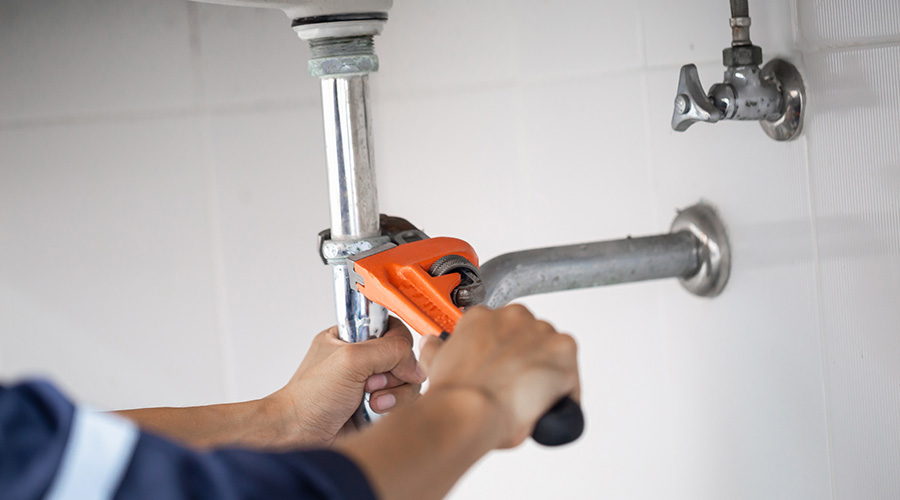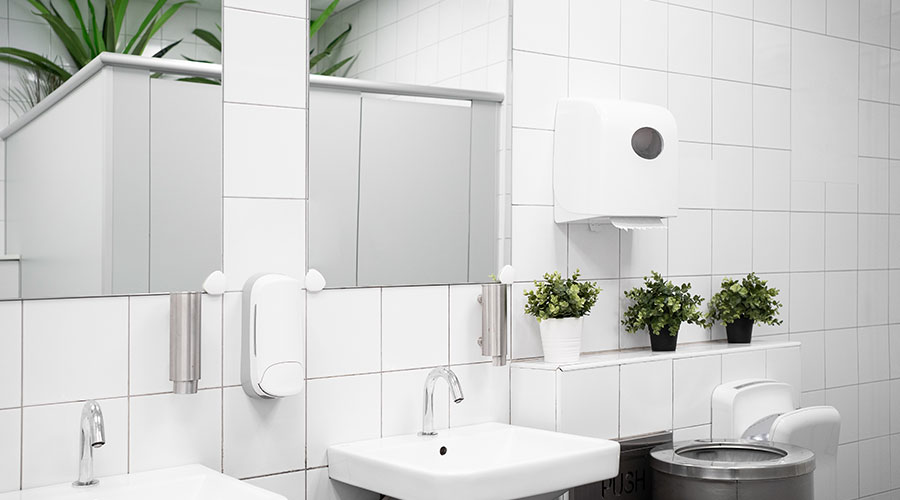Plumbing For Savings
Maintenance involvement early in the plumbing upgrade process ensures efficiency during installation and maintainability down the road
Restroom upgrades can help facilities provide greater access to visitors and occupants and control costs related to water use. But plumbing-system upgrades that fail to take post-project maintenance into consideration are doomed to fail.
By taking a closer look at key points in the plumbing upgrade process — including design and product specification — maintenance and engineering managers can find ways to influence design and specification decisions with the goal of ensuring efficient maintenance once a project is finished.
Design and Specification
One essential goal managers should emphasize during design and specification is_maintainability, which seeks to ensure that upgraded facilities and systems are maintainable once an upgrade is complete. Any pipe fitter or plumber who has had to repair piping or fixtures sandwiched in between or underneath obstructions, with no room for a tool knows how a lack of maintenance access can affect the job time.
For example, some sinks are designed so that the faucet nuts — the nuts under the sink that hold the faucet tightly to the sink surface — are up underneath the sink behind the drain and trap piping. They require an open-end wrench to turn, and the wrench jaws must be perpendicular to the wrench handle.
In a new installation, a faucet can be installed on a sink before the sink is installed on the wall. But if a faucet must be replaced, a special wrench might be needed for this purpose. Even with this special wrench, access can be so limited that a worker can get very little leverage to turn a nut and can only turn it a few degrees at a time. One result is a longer repair time.
On the other hand, checking clearances from the dimensional drawing of the fixture during the design stage can ensure there is adequate clearance for installation. These drawings are available from the manufacturer in the installation and maintenance literature or on the Web site and are certainly worth checking in advance.
To ensure during the design process that restroom upgrades comply with current regulations, managers can consult the latest building codes or have an architectural and engineering firm participate during the design process. Among the more important areas to consider are guidelines in the Americans with Disabilities Act (ADA), regulations from Occupational Safety and Health Administration (OSHA) and U.S. Environmental Protection Agency (EPA), and state and local building codes.
A key point to consider when specifying restroom fixtures is that ADA applies to all establishments with more than 15 employees. All establishments that serve the public, regardless of size, must adhere to the act’s provisions, which give excellent guidelines for compliance, including drawings with required clearance dimensions.
Besides covering accessibility and safety and health requirements for visitors and occupants, many regulations and guidelines also contain measures that conserve water, power and other resources. Conserving water has figured prominently in the design of the latest restroom fixtures. The amount of water used is a function of both flow rate and flow time. Many water closets, urinals, lavatories and shower heads now are designed for lower flow — in some cases, one-half the flow rate of previous designs.
Automatic sensors, which turn on the flow when needed and turn off the flow when the need ends, can significantly reduce the time water is flowing. These improvements in fixture design for lower flow rate and less flow time required can reduce the water bill substantially.
Planning for Post-installation
Managers can direct and influence the maintainability of upgraded restrooms — as well as plan for post-installation maintenance — in a number of ways. Here are a few of the most effective areas:
Check building codes. During specification, managers can review building codes for compliance. Often, a code has changed since the original construction, so copying previous installations might not provide the best example. A local building inspector can help with code details and provide examples of common code violations to be aware of before making the final specifications.
Check ADA requirements. Public establishments must provide access for all visitors and occupants. In existing establishments, this requirement means organizations must make reasonable modifications to provide access to restrooms and accessibility within restrooms.
Managers should pay particular attention to these areas: the force — 5 pounds or less — to open doors and turn on faucets or operate flush valves; proper doorway and toilet stall clearances for wheelchairs; at least one accessible restroom per floor; Braille signage giving restroom directions; clearance under and lowered height for lavatories and mirrors.
Set up preventive and predictive maintenance programs and schedules. Preventive and predictive maintenance programs are cost-effective strategies managers can use to influence the maintainability of plumbing systems. For more information on the role of PM, see the accompanying article on page 13, “Making PM Pay.”
Obtain manufacturer’s installation and maintenance instructions. Give them to technicians. These documents contain PM schedules, installation practices, design specifications, installation dimensions, required clearances, service piping locations, and spare parts lists.
Obtain recommended spare parts. Manufacturer manuals contain diagrams of all parts required, such as sink faucet cartridges. These internal moving parts wear out every year or two, depending on frequency of use.
Managers can use the suggested spare parts list to order the correct spares for the storeroom. Using standard fixtures for all restrooms requires storing only one or two spare cartridges, but using many designs requires keeping at least one of each design on hand.
Provide the right tools. Management requires technicians to have the right tools for new fixture designs. Some of these designs require tools not needed with the older designs. Also, not all technicians have the same set of tools. This issue is especially important when technicians supply their own tools.
Many departments perform tool inspections to improve technicians’ productivity. Supervisors compare the list of the tools that each technician should have to the tools in each toolbox. They note any discrepancies and the technician is required to purchase those tools. Some departments pay tool allowances for replacement of worn-out tools and equipment, as well as for buying tools for new applications.
While many of these opportunities for efficiency might seem to be common sense, they are outside the realm of responsibility of maintenance and engineering managers in many organizations. For this reason, managers might need to be more insistent than usual when involving themselves in plumbing system upgrades. The justification for doing so, however, is to lower the overall cost both during installation and beyond — a goal that any organization should understand and appreciate.
|
Making PM Pay
Preventive maintenance (PM) and predictive maintenance (PdM) of restrooms can pay off if they are structured correctly. Consider this example:
When specifications for new restroom equipment are complete, management can direct the planning staff to create PM methods and frequencies for each product, based on manufacturer recommendations.
Then, each day, cleaning crews should inspect all restroom fixtures and furniture, noting any deficiencies, and the planning staff can prepare work orders, according to a problem’s priority.
Obviously, stopped-up sinks or toilets require immediate response, while a slightly loose stall door latch that is still working would not require emergency response but could be done when a plumber is in the area working on another job.
Electronic sensors on flush valves and sinks that are battery operated give a visual signal when the battery is low. Usually, there are still several thousand cycles left when the signal for replacement starts to appear. This design means that a department has plenty of time to replace batteries on a routine maintenance work order, which can be combined with other work in the area to reduce travel time and eliminate interrupting other work.
A good PM/PdM program can significantly lower the life-cycle cost and raise the reliability of restroom equipment and furnishings.
|
Related Topics:











